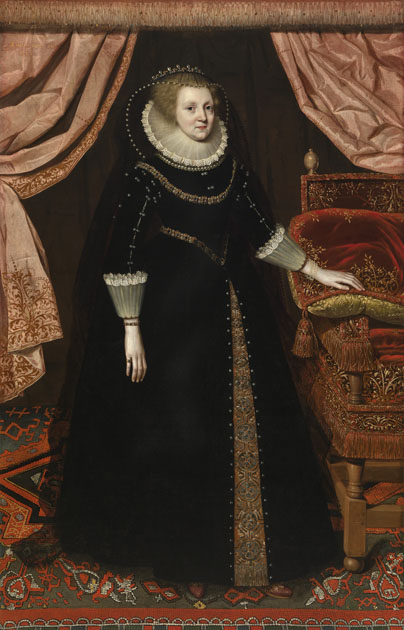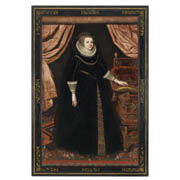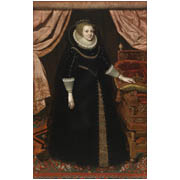Details
- Object type
painting
- Title
Elizabeth Wriothesley, née Vernon, Countess of Southampton
- Artist/Maker
Marcus Gheeraerts the school of, possibly
School of Marcus Gheeraerts school of
- Culture/School
Flemish; British
- Place Associated
England
- Date
1622
- Materials
oil on canvas
- Dimensions
framed: 2257 mm x 1547 mm x 65 mm;unframed: 2000 mm x 1290 mm
- Description
-
A full-length formal court portrait of Elizabeth Wriothesley, née Vernon, Countess of Southampton, aged 50, wearing a black velvet dress adorned with pearls and precious stones, with a white ruff around her neck and white cuffs at her wrists, with a jewelled girdle around her waist and a matching necklace around her shoulders. She also wears a string of pearls around her neck, a pearl bracelet around her left wrist and a gold bracelet with square diamonds around her right. On her right little finger is a diamond ring. Her arched headpiece which is also encrusted with pearls has a black veil attached that extends to the floor. She is shown in sumptuous surroundings, standing on a precious Turkish carpet, framed by heavy embroidered curtains. Her hand rests on a richly embroidered chair that was probably the chair she was given at the coronation of James VI as James I of England. It shows not only that she has wealth, but also a title. To this day embroidered chairs are prerequisites from coronations and investitures of the Prince of Wales. Her pose, with one hand on the chair, was the standard formula for aristocratic formal portraiture.
Elizabeth Vernon was born on 11 January 1572, the daughter of John Vernon of Hodnet, Shropshire, and Elizabeth Devereaux. Maid of Honour to Queen Elizabeth I, she was one of the most celebrated beauties at court. She married Henry Wriotheseley, 3rd Earl of Southampton (1573-1624), in a hasty marriage in 1598, following a secret affair and pregnancy, incurring the Queen’s wrath. Both were briefly imprisonment in Fleet Prison and after their release were not received at court. Their first child, Penelope, was born on 18 November 1598. They had three further children: a son who died in infancy; Thomas, later 4th Earl of Southampton, in 1607; and another daughter Anne.
Wriothesley had been a royal ward under the care of Lord Burghley. He studied at Cambridge and Gray’s Inn, becoming a patron of the arts, especially literature. Shakespeare’s Venus and Adonis was dedicated to him. He was tried for treason in 1603 for collaborating in the Earl of Essex’s rebellion, although Sir Robert Cecil managed to have his sentence commuted from death to life imprisonment. On the accession of James VI and I to the English throne, he resumed his place at court. He became a member of Prince Henry’s circle, playing a part in the masque Oberon (1611), one of the celebratory events for his investiture as Prince of Wales.
The clothes that the Countess wears in this portrait would suggest that she is in mourning. Her ruff is plainer than the elaborately decorated lace ruffs found in her earlier portraits. Hoods and veils were out of fashion by the early 17th century, usually only worn by older women and widows. The Countess’ husband and eldest son both died in 1624, two years after this portrait was painted. However, she could have been in mourning for another family member such as a sibling or cousin. The Countess herself died on 23 November 1655.
The portrait has been attributed to the School of Marcus Gheeraerts the Younger, a Flemish artist working in the Tudor court. His father Marcus Gheeraerts the Elder was also a painter. Born in Bruges, Gheeraerts the Younger came to England as a boy and rose to become one of the most fashionable portraitists of his day. His portraits are known for their close observation and detail, and for their use of tone and modelling to suggest physical substance, in contrast to earlier portraiture which had been very flat. He also painted on canvas, rather than wood panel, allowing for much bigger portraits to be made. It is thought that he had a large studio workshop with many assistants. However, by the late 1610s, he had fallen out of fashion.
- Credit Line/Donor
Purchased by the Burrell Trustees with the assistance of the Heritage Lottery Fund, 1999
- Collection
Burrell Collection: Pictures [Oils, Pastels and Watercolours]
- ID Number
35.672
- Location
Burrell Collection


